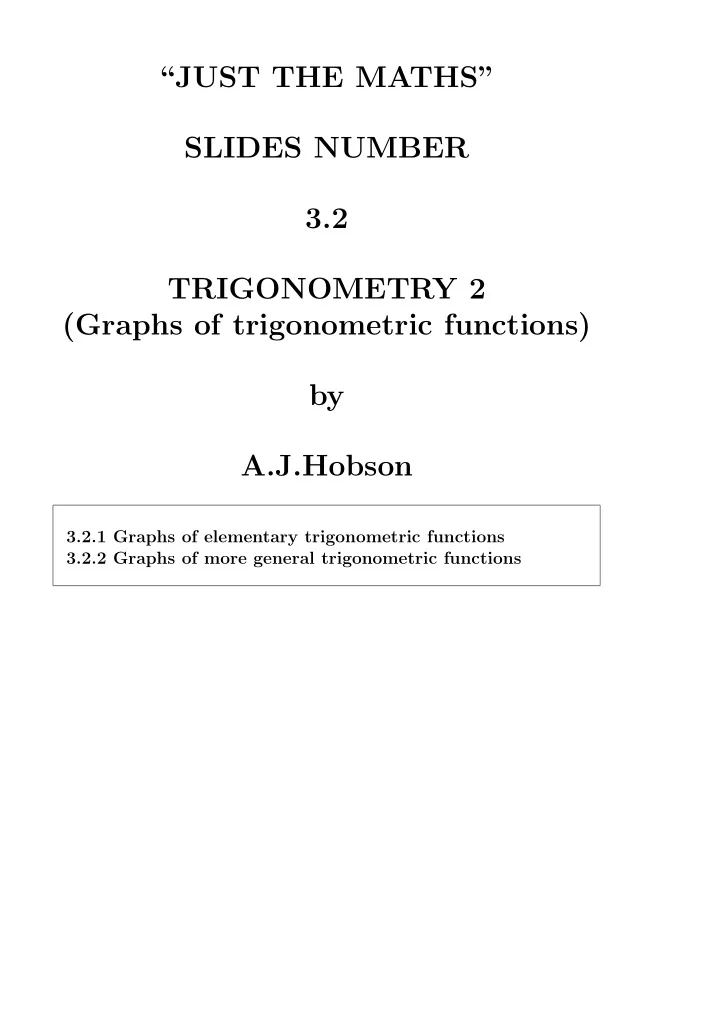

“JUST THE MATHS” SLIDES NUMBER 3.2 TRIGONOMETRY 2 (Graphs of trigonometric functions) by A.J.Hobson 3.2.1 Graphs of elementary trigonometric functions 3.2.2 Graphs of more general trigonometric functions
UNIT 3.2 - TRIGONOMETRY 2 GRAPHS OF TRIGONOMETRIC FUNCTIONS 3.2.1 GRAPHS OF ELEMENTARY TRIGONOMETRIC FUNCTIONS 1. y = sin θ ✻ y 1 x ✲ 0 − 4 π − 3 π − 2 π − π 2 π 3 π π − 1 Results and Definitions (i) sin( θ + 2 π ) ≡ sin θ. sin θ is a “periodic function with period 2 π ” . (ii) Other periods are ± 2 nπ where n is any integer. (iii) The smallest positive period is called the “primitive period” or “wavelength” . (iv) sin( − θ ) ≡ − sin θ and sin θ is called an “odd function” . 1
2. y = cos θ ✻ y 1 ✲ x − 4 π − 3 π − 2 π − π 0 2 π 3 π π − 1 Results and Definitions (i) cos( θ + 2 π ) ≡ cos θ. cos θ is a periodic function with primitive period 2 π . (ii) cos( − θ ) ≡ cos θ and cos θ is called an “even function” . 2
3. y = tan θ y ✻ x ✲ 0 − π π − π π 2 2 Results and Definitions (i) tan( θ + π ) ≡ tan θ. tan θ is a periodic function with primitive period π . (ii) tan( − θ ) ≡ − tan θ and tan θ is called an “odd function” . 3
3.2.2 GRAPHS OF MORE GENERAL TRIGONOMETRIC FUNCTIONS In scientific work, it is possible to encounter functions of the form Asin( ωθ + α ) and Acos( ωθ + α ) , where ω and α are constants. EXAMPLES 1. Sketch the graph of y = 5 cos( θ − π ) . Solution (i) the graph will have the same shape as the basic cosine wave; (ii) the graph will lie between y = − 5 and y = 5 so has an “amplitude” of 5; (iii) the graph will cross the θ axis at the points for which 2 , ± 3 π 2 , ± 5 π θ − π = ± π 2 , ...... that is θ = − 3 π 2 , 3 π 2 , 5 π 2 , − π 2 , π 2 , ...... 4
(iv) The y -axis must be placed between the smallest negative intersection with the θ -axis and the small- est positive intersection with the θ -axis (in propor- tion to their values). In this case, the y -axis must be placed half way be- tween θ = − π 2 and θ = π 2 . ✻ y 5 ✲ x − 4 π − 3 π − 2 π − π 0 2 π 3 π π − 5 Note: 5cos( θ − π ) ≡ − 5cos θ so that graph is an “upsidedown” cosine wave with an amplitude of 5. Not all examples can be solved in this way. 5
2. Sketch the graph of y = 3 sin(2 θ + 1) . Solution (i) the graph will have the same shape as the basic sine wave; (ii) the graph will have an amplitude of 3; (iii) The graph will cross the θ -axis at the points for which 2 θ + 1 = 0 , ± π, ± 2 π, ± 3 π, ± 4 π, ...... That is, θ = ... − 6 . 78 , − 5 . 21 , − 3 . 64 , − 2 . 07 , − 0 . 5 , 1 . 07 , 2 . 64 , 4 . 21 , 5 . 78 ... (iv) The y -axis must be placed between θ = − 0 . 5 and θ = 1 . 07 but at about one third of the way from θ = − 0 . 5 y ✻ 3 x ✲ − 6 . 78 − 5 . 21 − 3 . 64 − 2 . 07 − 0 . 5 1 . 07 2 . 64 4 . 21 − 3 6
Recommend
More recommend